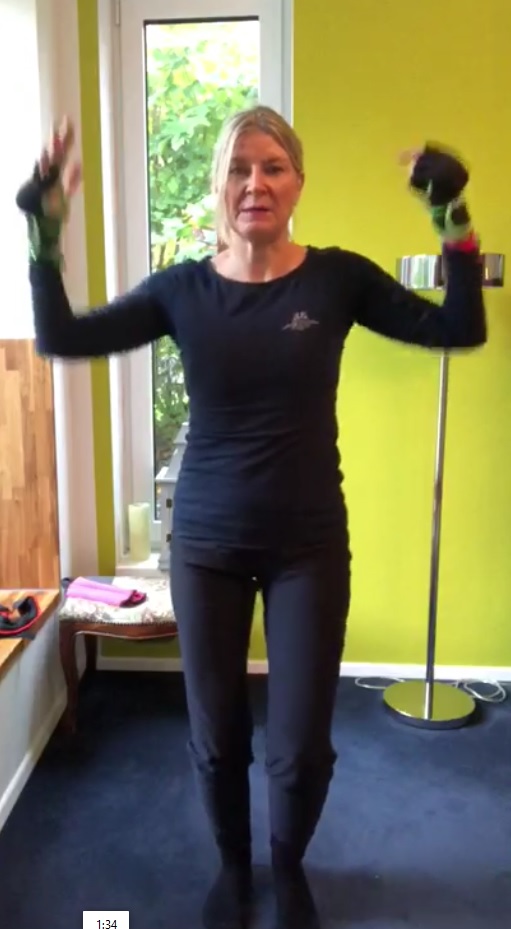How to Get into a Binge-Watch Fitness Routine
by Gerda
Why a stay-at-home workout might be a good idea for the pandemic
Three years ago, I had all the symptoms of Hashimoto’s thyroiditis: I had gained weight, was exhausted and dizzy. Being a busy person, I am a business owner, mother of two teenagers and a Harvard grad student, I had to find creative ways to squeeze in some extra time for my well-being.
One evening, during my family’s popular gathering for the The Big Bang Theory, I jumped off the sofa and started walking on the spot. Still today, I exercise several times a week for 30 to 60 minutes. I walked through all seasons of Sex and the City without ever Breaking Bad. I have lost more than 20 pounds, feeling much more energized and mentally strong.
I walked through all seasons of Sex and the City without ever Breaking Bad.
As a former fitness and aerobics instructor with 15 years of work experience, I knew how to create an easy-to-follow fitness routine for my binge-watch craving:
It is basically a combination of joint-friendly low impact aerobics for endurance plus muscle strength exercises. It’s easy, time-friendly, inexpensive and doesn’t require more than a small spot next to your TV.
TV Workout is easy, time-friendly and inexpensive
Especially now – living with Coronavirus restrictions – you might want to try my routine. A research paper from June 2020 about the severe COVID-19 situation in Italy said that, “Given the spread of COVID-19, stay at home is a fundamental step to halt the pandemic.” The authors further concluded that, “maintaining a regular exercise routine is a key strategy for physical and mental health during a forced rest period like the current corona virus emergency.”
“Given the spread of COVID-19, stay at home is a fundamental step to halt the pandemic.”
Maugeri et al., 2020, p. 7
Physical and mental health is also an issue, when it comes to binge-watching. A May-2020 study showed that, “binge-watching can be both harmonious and highly entertaining as well as an obsessive and compensatory behavior.” Therefore, try to follow my advice and turn off the program after you enjoyed your workout.
Also, before you start exercising, make sure you are healthy enough and always consult a doctor, if you have questions about a medical condition or health objectives.
TV Workout – How it works:
FIND A SPACE
Position yourself in front of or next to the screen, step forward and back, left and right. If you have enough space to drop into a push-up or plank position, you’re all set.
Tip: Look behind you – you might irritate those couch potatoes in the back.
HOW LONG IT TAKES
I favor evening workouts, but you can binge and exercise anytime. The World Health Organization recommends 150 minutes of moderate workout for healthy adults per week, so that comes to five episodes of Friends or two to three episodes of Game of Thrones.
Tip: Find a show you love and resolve to only watch it while working out.
WHAT TO WEAR
At home, I don’t worry about outfit – I usually put on some jogging pants and a T-shirt, and – since movements are joint-friendly – only wear slipper socks. For muscle strength, I put on fitness gloves or heavy hands. You can also use filled water bottles as weights…wine bottles? Not so much, better drink the wine.

Tip: Skip the weights in the beginning. After a couple of times, if you feel ready for an extra challenge, add weights to the upper and lower body exercises.
For more intense results, wear a fitness vest. Use a yoga mat, if you have neighbors downstairs.
Exercise examples for beginners – keeping it simple
If you want to have two-in-one – fun watching TV while doing something good for body and mind – remember the basic principle:
Keep it simple.
Start by turning on your favorite show and walking on the spot for a couple of minutes, arms slightly bent. Try to control your arm muscles when swaying back and forth. This will warm your muscles and get your heart pumping more blood. Whenever you feel it’s time for a change, start a step touch, plie touch, or a plie kick – with bigger arms movements along with your steps.

Add arm-toning exercises whenever you feel ready for a change:
Do a bicep curl,
a triceps curl,
shoulder presses,
chest presses or
side lifts,
alternate the arm movements in
sets of eight.
Experiment with intervals and add some more muscle strength doing squats, lunges, triceps dips, pushups, planks or leg lifts in sets of eight for each exercise.
Tip: In case you watch TV instead of streaming, you can always squeeze in some more repetitions of intense squads, lunges, planks, pushups or leg lifts during breaks. Don’t forget to keep hydrated -drink enough water!
Stretch and relax
After the cardio-/muscle part, cool down, stretch and relax for a few minutes. A post-workout cooldown can reduce injury and stress, calming you down for bedtime. For example, sit on the floor, legs slightly bent forward or to each side, touch your toes and feel the stretch in the back and legs. Try some yoga stretches like the downward dog or the cat-cow stretch. Lie on the floor for a while, feel your breath and let loose.
Tip: Remember to turn off the TV after you finished your workout.
Start small and be patient with noticing results – it might take a couple of weeks.
Sources:
Maugeri G, Castrogiovanni P, Battaglia G, Pippi R, D’Agata V, Palma A, Di Rosa M, Musumeci G. The impact of physical activity on psychological health during Covid-19 pandemic in Italy. Heliyon. 2020 Jun 24;6(6):e04315. doi: 10.1016/j.heliyon.2020.e04315. PMID: 32613133; PMCID: PMC7311901. https://www.cell.com/heliyon/fulltext/S2405-8440(20)31159-2
Physical Activity and Adults. The World Health Organization. Retrieved October 14, 2020 from https://www.who.int/dietphysicalactivity/factsheet_adults/en/
Starosta, J. A., & Izydorczyk, B. (2020). Understanding the Phenomenon of Binge-Watching—A Systematic Review. International Journal of Environmental Research and Public Health, 17(12), 4469. MDPI AG. Retrieved from http://dx.doi.org/10.3390/ijerph17124469
Further Reading:
Reynolds, G. (2013). The first twenty minutes: The myth-busting science that shows how we can walk farther, run faster, and live longer. New York, New York: Penguin.
KIrsch, M. (2020, October 7). How We Exercise During a Pandemic. It’s one way of residing in a body. Retrieved October 15, 2020, from https://www.nytimes.com/2020/10/07/at-home/newsletter.html?action=click&block=more_in_recirc&impression_id=b2e998e0-0be2-11eb-94f1-570e6906c763&index=0&pgtype=Article®ion=footer